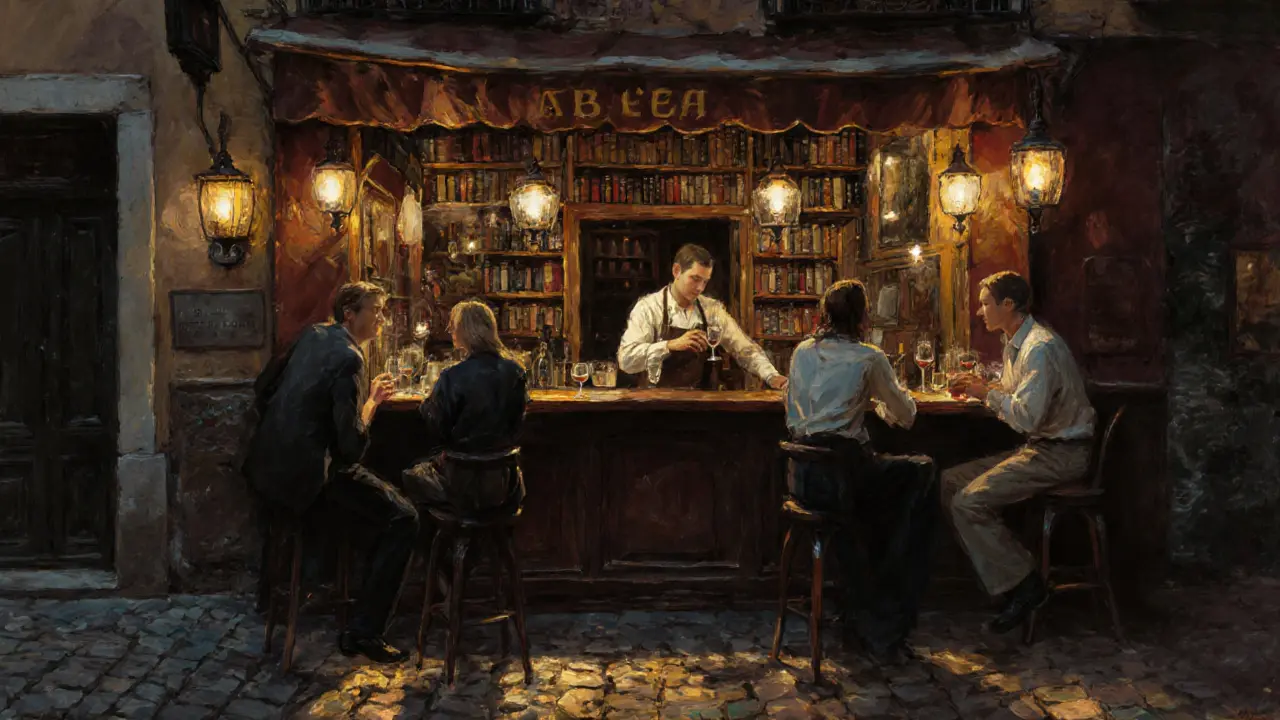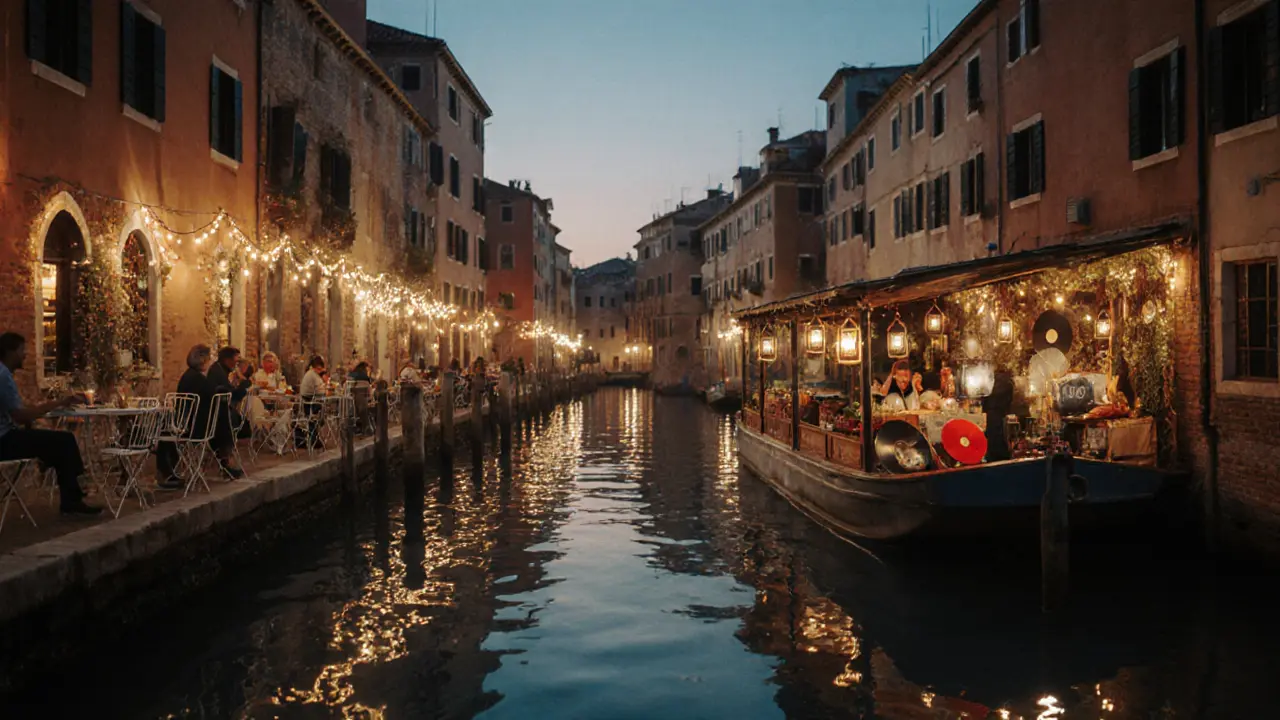When the sun sets over Milan, the city doesn’t sleep-it switches gears. The sleek, fashion-forward streets of Brera and the canals of Navigli transform into pulsing corridors of music, laughter, and clinking glasses. This isn’t just about drinking; it’s about how Milanese people live after dark. You won’t find rowdy college bars or tourist traps here. Instead, you’ll find hidden speakeasies, rooftop lounges with skyline views, and underground clubs where DJs spin everything from techno to Italian disco. If you’re looking for a night out that feels authentic, not staged, Milan delivers.
Start in Navigli: The Canals That Never Sleep
Head to Navigli, the historic canal district, and you’ll understand why locals call it the heart of Milan’s nightlife. On Friday and Saturday nights, the sidewalks along the Darsena and Grande canals fill with people sipping Aperol spritzes under string lights. The bars here aren’t loud, packed clubs-they’re cozy, open-air spots with mismatched chairs and vinyl records spinning in the background. Bar Basso, opened in 1958, still serves the original Negroni Sbagliato, and the line outside proves it’s worth the wait. Nearby, La Cucina di Navigli turns into a wine bar after 9 p.m., with 40+ Italian labels by the glass and live jazz on weekends.
Don’t miss the floating bars. Barca and Il Burchio are boats anchored along the canal, serving cocktails as you drift past lantern-lit facades. It’s romantic, quiet, and unlike anything you’ll find in Rome or Florence. Locals come here to unwind after work, not to dance until dawn. If you want to feel like a Milanese, start here.
Brera: Where Art Meets After-Hours
Just a 15-minute walk from Navigli, Brera is Milan’s intellectual and artistic soul. By day, it’s filled with galleries and bookshops. By night, it’s a maze of intimate wine bars and cocktail lounges tucked behind unmarked doors. Bar del Fico is a favorite among designers and artists. It’s tiny, no bigger than a living room, with mismatched vintage lamps and a menu that changes weekly based on what’s fresh at the market. They don’t take reservations-just show up at 9 p.m. and grab a stool.
For something more upscale, try La Peretta. This place looks like a 1920s library, with leather-bound books lining the walls and a bartender who knows your name after one drink. Their gin collection includes rare Italian botanicals, and the negroni here is so perfectly balanced, you’ll stop comparing it to every other one you’ve ever had.
Brera doesn’t have clubs. It has conversations. If you’re looking for a night of deep talk, good wine, and maybe a little poetry reading, this is your spot.
Porta Venezia and the Underground Scene
If you want to dance until sunrise, head to Porta Venezia. This neighborhood is where Milan’s queer, alternative, and electronic music scenes thrive. Capo d’Africa is a legendary spot that’s been running since the 1980s. It’s not fancy-concrete floors, sticky tables, and a sound system that shakes your ribs. But it’s where local DJs test new tracks and international acts drop in unexpectedly. The crowd? Mixed, loud, and completely unpretentious.
For a more polished experience, La Scala Club (not to be confused with the opera house) plays deep house and techno in a converted warehouse. They don’t advertise. You find out about events through Instagram stories or word of mouth. Entry is €10, but the vibe is priceless. This is where Milan’s underground music culture lives-not in flashy clubs, but in places that feel like secrets.
On Sundays, Barbapedana opens at 10 p.m. for a retro night of 80s and 90s Italian pop. It’s the only place in the city where grandmas and twenty-somethings dance side by side to Eros Ramazzotti and Gianna Nannini. It’s chaotic, joyful, and totally Milan.

The Rooftop Experience: Views and Cocktails
Milan’s skyline is one of its best features, and the best way to see it is from above. Terrazza Aperol at the Hotel Principe di Savoia offers panoramic views of the Duomo and Galleria Vittorio Emanuele II. The cocktails are expensive-€22 for a spritz-but the sunset over the cathedral is worth it. It’s a place for date nights and special occasions.
For something more local, try La Terrazza at the Armani Hotel. It’s quieter, more refined, and less touristy than the Aperol spot. They serve craft gin cocktails made with Italian herbs and a selection of small plates that pair perfectly with the night air. You won’t find DJs here, just soft piano music and the occasional murmur of Italian conversation.
Don’t skip the rooftop at Hotel Cavour in the heart of the city. It’s free to enter after 9 p.m., and they serve cheap wine by the carafe. Locals come here to watch the city lights come on without spending a fortune. It’s the kind of place you’ll remember long after you’ve left.
When to Go and What to Wear
Milan’s nightlife doesn’t start early. Bars don’t fill up until after 10 p.m., and clubs don’t hit their stride until midnight. Don’t show up at 8 p.m. expecting a party-you’ll be the only one there.
As for dress code: Milan doesn’t require suits, but it does expect effort. No flip-flops, no hoodies, no athletic wear. Even in the underground clubs, people dress with intention. Think dark jeans, a stylish jacket, and clean shoes. Women often wear tailored tops or little black dresses. It’s not about being rich-it’s about showing you care about how you present yourself.
On weekends, lines form outside popular spots. If you’re going to a club, ask your hotel concierge for an invite list. Many places reserve spots for guests of local hotels. Walk-ins are possible, but you might wait an hour.

What Not to Do
Don’t ask for a “party” in Milan. The word doesn’t mean the same thing here as it does in Miami or Berlin. Milanese nightlife is about atmosphere, not volume. If you’re loud, drunk, or demanding, you’ll be politely asked to leave.
Don’t try to force a club experience if you’re not into music. Milan’s best nights are spent in quiet bars, walking along the canals, or sharing a bottle of Barolo with friends.
And don’t skip the aperitivo. It’s not just a drink-it’s a ritual. From 6 p.m. to 9 p.m., most bars offer a free buffet with snacks like olives, crostini, and mini sandwiches if you order a drink. It’s the cheapest way to eat a full meal in the city.
Final Tips for a Perfect Night
- Use the metro after midnight-it runs until 1:30 a.m. on weekends.
- Carry cash. Many small bars don’t take cards.
- Download the Eventbrite app. Local events, pop-up parties, and art nights are posted there.
- Ask a bartender where they go after their shift. They’ll point you to the real spots.
- Don’t rush. Milan’s nightlife is meant to be savored, not checked off a list.
There’s no single “best” night in Milan. It’s the combination of a quiet canalside drink, a surprise jazz set in Brera, a late-night dance in Porta Venezia, and a rooftop toast under the stars that makes it unforgettable. You don’t come to Milan for the party-you come for the feeling.
Is Milan nightlife safe at night?
Yes, Milan is generally safe at night, especially in popular nightlife areas like Navigli, Brera, and Porta Venezia. The streets are well-lit, and there’s a strong police presence on weekends. Avoid isolated alleys and don’t carry large amounts of cash. Stick to busy areas and use official taxis or the metro after midnight.
What’s the best night to go out in Milan?
Friday and Saturday nights are the busiest and most lively. Clubs and bars are fully operational, and the crowds are energetic. For a more relaxed vibe, try Thursday or Sunday-many locals prefer these nights for wine bars and live music without the rush.
Do I need to book a table for dinner before going out?
Not unless you’re going to a Michelin-starred restaurant. For most casual spots, especially in Navigli and Brera, you can walk in. But if you want to eat before the nightlife starts, book a table for 7:30-8 p.m. to avoid waiting. Many bars offer aperitivo buffets, so you don’t need to eat a full dinner.
Are there any age restrictions for clubs in Milan?
Most clubs require you to be at least 18, but many popular ones, especially in Porta Venezia, enforce a 21+ policy. Always carry ID. Some underground venues check ID less strictly, but it’s better to be prepared. You’ll be turned away without it.
Can I find English-speaking staff in Milan’s nightlife spots?
In tourist-heavy areas like Navigli and the Duomo district, yes-most bartenders speak basic English. But in Brera and Porta Venezia, many staff speak little to no English. Learning a few Italian phrases like "Un aperitivo, per favore" or "Quanto costa?" goes a long way. Locals appreciate the effort.
How much should I budget for a night out in Milan?
You can have a great night for €30-€50. Aperitivo (drink + food) costs €12-€18. A cocktail in a rooftop bar is €15-€22. Club entry is €10-€15, and drinks inside run €8-€12. Skip the tourist traps near the Duomo-prices there are inflated. Stick to local neighborhoods for real value.

Caspian Beauchamp
Hello, my name is Caspian Beauchamp, and I am an expert in the world of escort services. With years of experience in the industry, I have developed a deep understanding of the dynamics and nuances of escort services in various cities. My passion for writing has led me to share my insights and knowledge through articles and blog posts, helping others navigate the world of companionship and pleasure. I pride myself on providing honest, accurate, and engaging content that appeals to a wide range of readers. Join me as I explore the fascinating world of escorts and the unique experiences they offer in cities around the globe.